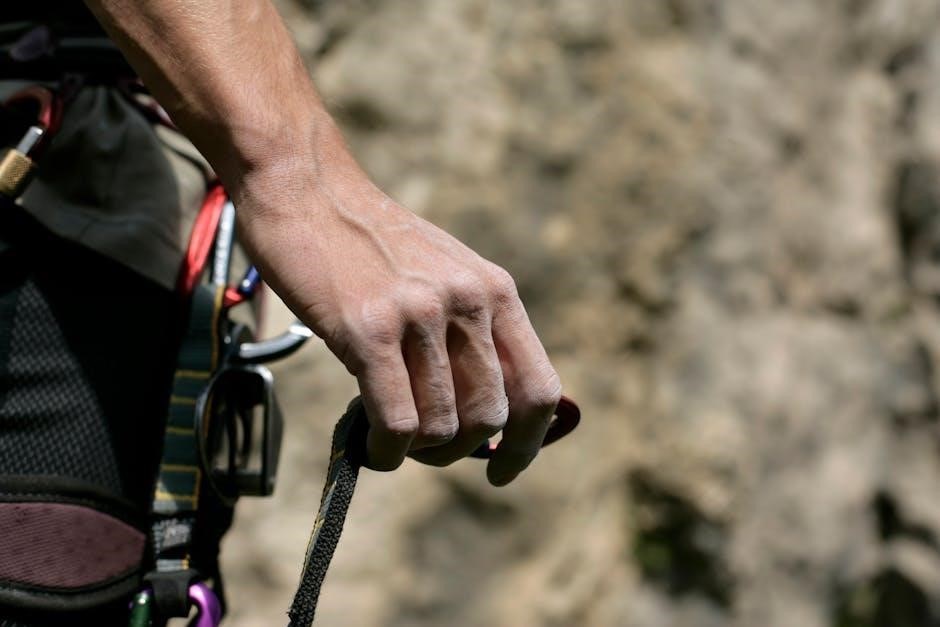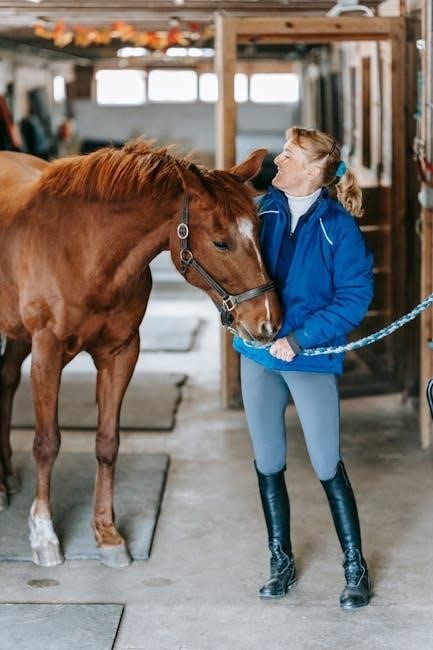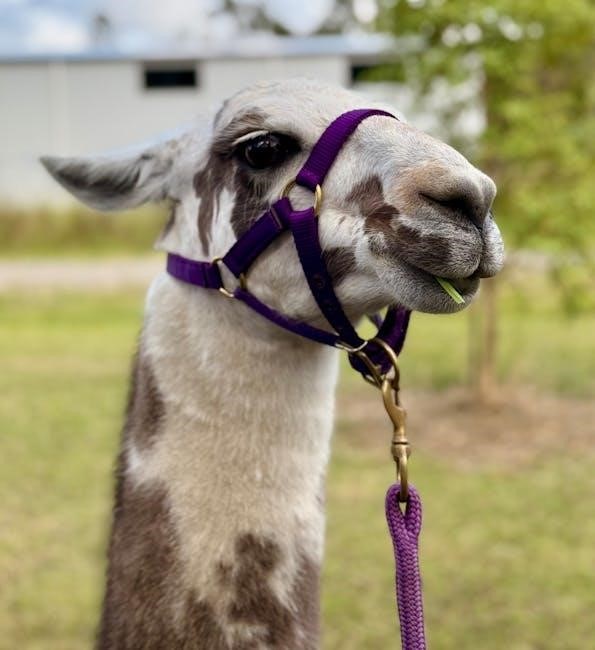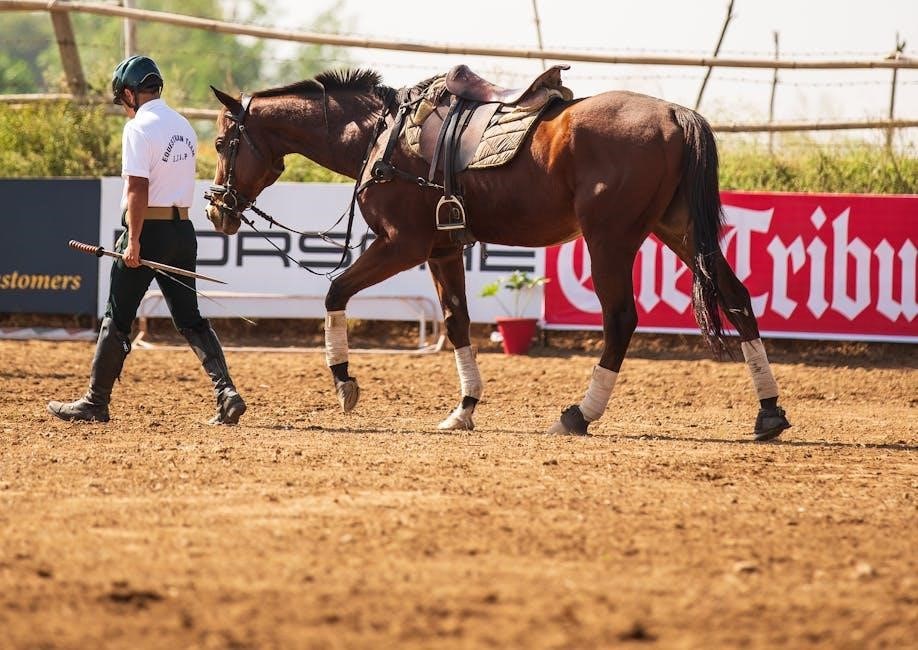A harness lead is a training tool designed to provide better control and comfort for dogs, reducing neck strain and preventing escape attempts during walks․
1․1 What is a Harness Lead?
A harness lead is a combination of a dog harness and a leash, designed to distribute force across the dog’s chest and shoulders, reducing neck strain․ It often features a double-ended design, allowing attachment to both front and back clips for better control and training․ This setup is ideal for dogs that pull or escape, providing comfort and security during walks․
1․2 Benefits of Using a Harness Lead
A harness lead reduces neck strain and prevents choking, making it safer for dogs․ It provides better control for owners, especially with strong or eager dogs․ The design distributes force across the chest and shoulders, enhancing comfort․ Ideal for dogs that pull or escape, it offers versatility for training and everyday walks, promoting a more enjoyable and stress-free experience for both dog and owner․
Components of a Harness Lead
A harness lead consists of a padded vest with straps, D-rings for leash attachment, and a double-ended lead with clips, offering versatility and control during walks․
2․1 Parts of the Harness
The harness includes a chest plate, shoulder straps, and belly bands․ These components distribute pressure evenly, preventing discomfort or injury․ Some models feature reflective material for visibility, while others have adjustable straps for a customizable fit․ The D-ring attachments are typically located on the chest and back, allowing for versatile leash connections․ Properly fitted harnesses ensure comfort and safety during walks or training sessions․
2․2 Parts of the Lead
The lead consists of a durable strap with two clips, allowing attachment to both the chest and back D-rings of the harness․ This dual-clip design enables effective anti-pull training․ The lead’s length is adjustable, offering flexibility in controlling your dog․ Handles or grip points provide comfort for the owner, while reinforced stitching ensures longevity and strength, making it suitable for both daily walks and training sessions․

Choosing the Right Harness
Selecting the right harness involves considering your dog’s size, breed, and behavior․ Measure your dog accurately to ensure a comfortable, secure fit․ Choose durable materials and adjustable straps for optimal support and control․
3․1 Types of Harnesses (Front-Clip, Top-Clip, Dual-Clip)
Harnesses come in three main types: front-clip, top-clip, and dual-clip․ Front-clip harnesses attach the leash to the dog’s chest, ideal for dogs that pull, as they allow sideways control․ Top-clip harnesses attach to the back, suitable for well-behaved dogs․ Dual-clip harnesses offer both options, providing flexibility for training and everyday use, ensuring versatility for different walking scenarios and training needs․
3․2 Measuring Your Dog for the Correct Fit
Accurate measurement is crucial for a comfortable harness fit․ Use a flexible tape measure around the broadest part of your dog’s chest, just behind the front legs․ Ensure the harness isn’t too tight or loose, allowing for two fingers’ width between the straps and your dog’s body․ Proper fit prevents discomfort and ensures effective control during walks, promoting safety and comfort for your pet․
3․3 Material and Durability Considerations
Choose a harness made from durable, breathable materials like nylon or polyester for lasting use․ Look for reinforced stitching and sturdy hardware to ensure reliability․ Reflective elements enhance visibility in low light, while padded areas improve comfort․ High-quality materials not only extend the harness’s lifespan but also provide a secure and comfortable fit, making it suitable for long-term use and various weather conditions․

Understanding the Double-Ended Lead
A double-ended lead is designed to provide greater control and versatility, allowing attachment to two points on a dog’s harness for effective anti-pull training and better steering․
4․1 What is a Double-Ended Lead?
A double-ended lead is a versatile training tool featuring two clips, allowing attachment to both the front and back of a dog’s harness․ This design enhances control, making it ideal for managing strong pullers and providing precise steering․ It promotes safer walking by distributing pressure and minimizing neck strain, while offering flexibility in training techniques and everyday use․
4․2 Benefits of Using a Double-Ended Lead
A double-ended lead offers enhanced control and safety for both dog and owner․ It allows for effective anti-pull training by attaching to both front and back harness points, reducing strain on the dog’s neck․ This setup enables better steering, making it easier to guide strong pullers․ Additionally, it provides a comfortable and secure way to walk dogs, promoting positive behavior and strengthening the bond between owner and pet․

Putting on the Harness
Putting on the harness involves guiding it over your dog’s head, ensuring proper orientation, and adjusting for a snug, comfortable fit․ Introduce it slowly with rewards․
5․1 Step-by-Step Guide to Fitting the Harness
Begin by laying the harness flat on the ground․ Gently place your dog’s front paws into the leg holes, ensuring the harness is correctly oriented․ Guide the harness over your dog’s head and secure the belly strap first, followed by the chest and shoulder straps․ Adjust all straps to ensure a snug, comfortable fit, allowing for two fingers of space between the harness and your dog’s skin․ Ensure proper alignment and comfort before attaching the lead․
5․2 Introducing the Harness to Your Dog
Introduce the harness gradually to avoid overwhelming your dog․ Start by letting them explore it at their own pace, offering treats for calm behavior․ Place the harness on your dog without tightening the straps, allowing them to become familiar with the feel․ Reward positive reactions and progress slowly, ensuring a stress-free experience․ This method builds trust and makes future use of the harness easier and more enjoyable for both you and your dog․
Adjusting the Harness
Adjust the harness to ensure a snug, comfortable fit, allowing two fingers to fit between the straps and your dog’s body․ Avoid tightness to prevent discomfort or injury, and looseness to maintain control and safety during walks․ Regularly check and adjust the harness as needed, especially as your dog grows or their weight changes, to ensure optimal comfort and effectiveness․
6․1 How to Properly Tighten the Harness
To properly tighten the harness, ensure all straps are snug but not restrictive․ Start by adjusting the chest plate, then the shoulder and belly straps․ Use the two-finger rule: you should be able to fit two fingers comfortably between the harness and your dog’s skin․ Avoid overtightening, which can cause discomfort or restrict movement․ Regularly check the fit, especially during walks, to ensure your dog remains comfortable and secure․
6;2 Ensuring Comfort and Safety
Ensure your dog’s comfort by using a well-fitted harness made from breathable, durable materials․ Avoid excessive tightness, as it can restrict movement or cause skin irritation․ Monitor your dog for signs of discomfort, such as labored breathing or reluctance to move․ Regularly inspect the harness for wear and tear, and adjust the fit as needed․ Proper use of the double-ended lead enhances control while maintaining your dog’s safety and well-being during walks․
Attaching the Lead
Attach the lead to your dog’s harness by clipping it to the D-ring(s) on the front, back, or both, depending on your training needs and the type of harness used․
7․1 Attaching the Lead to the Harness
To securely attach the lead, locate the D-ring on your dog’s harness․ For standard control, clip the lead to the back D-ring․ For training purposes, use the front D-ring to discourage pulling․ If using a double-ended lead, attach one clip to the front and the other to the back, allowing for better steering and control during walks․
7․2 Using the Double-Ended Lead Effectively
Clip one end of the double-ended lead to the front D-ring of the harness for steering and the other to the back D-ring for braking․ This setup allows you to guide your dog gently and reduce pulling behavior․ Use voice commands to reinforce good walking habits, ensuring a comfortable and controlled experience for both you and your dog during walks․
Training with the Harness Lead
The harness lead is an effective tool for anti-pull training, helping dogs learn to walk calmly․ Use it to guide your dog and reward good behavior․
8․1 Basic Training Tips
Start with short sessions to help your dog adjust to the harness․ Use voice commands like “walk” or “heel” to guide them․ Reward calm behavior with treats and praise․ Avoid pulling back on the lead; instead, gently guide your dog․ Consistency is key to helping your dog understand and respond positively to the harness lead․
8․2 Using Voice Commands and Rewards
Use clear, consistent voice commands like “walk” or “heel” to guide your dog․ Positive reinforcement with treats and praise encourages good behavior․ Reward your dog when they respond correctly, such as walking calmly by your side․ Consistency in commands and rewards helps build trust and ensures your dog understands and responds effectively to the harness lead․

Common Mistakes to Avoid
Incorrect fit of the harness and improper use of the lead are common mistakes․ Ensure the harness is snug but not tight and use the lead correctly to maintain control․
9․1 Incorrect Fit of the Harness
An improperly fitted harness can cause discomfort or injury․ Ensure the harness is snug but not restrictive, allowing free movement․ A too-tight fit can impede breathing, while a too-loose fit may lead to escape attempts․ Regularly check the fit, especially for growing puppies, to maintain comfort and safety during walks․ Proper adjustment is key to effective use․
9․2 Improper Use of the Lead
Incorrectly using the lead can undermine its effectiveness and pose safety risks․ Avoid clipping both ends to the same D-ring, as this defeats the purpose of a double-ended lead․ Never pull excessively, as it can harm your dog or cause loss of control․ Ensure the lead is used as intended, not as a restraint, and always adjust its length appropriately to maintain control and comfort during walks․

Maintenance and Care
Regularly clean the harness and lead with mild soap and water to prevent dirt buildup․ Store them in a cool, dry place to maintain durability and prevent damage․
10․1 Cleaning the Harness and Lead
Use mild soap and warm water to gently scrub the harness and lead, removing dirt and odors․ Avoid harsh chemicals or bleach, as they can damage materials․ Rinse thoroughly and air-dry to prevent moisture buildup․ Regular cleaning ensures longevity and keeps the gear hygienic for your dog․ This simple routine maintains comfort and durability, ensuring optimal performance during walks and training sessions․
10․2 Storing the Harness and Lead
Store the harness and lead in a cool, dry place to prevent moisture buildup and damage․ Avoid folding or creasing the lead, as it may weaken the material․ Hang the harness to maintain its shape and keep it clean․ Proper storage extends the lifespan of the gear, ensuring it remains in great condition for future use with your dog․

Troubleshooting
Troubleshooting common issues like pulling or escaping ensures effective use of the harness lead․ Address these problems with proper training and equipment adjustments for better control․
11;1 My Dog is Pulling Too Hard
If your dog pulls too hard, ensure the harness fits correctly and use a front-clip attachment for better control․ Reward calm behavior and consider using a double-ended lead for additional steering․ Consistent training with positive reinforcement can help reduce pulling over time;
11․2 My Dog is Trying to Escape the Harness
If your dog is trying to escape the harness, ensure it fits correctly and avoid harsh corrections․ Introduce the harness slowly, using treats and positive reinforcement․ Consider an escape-proof design or additional safety features․ Regular adjustments and consistent training can help build trust and prevent escape attempts during walks․
Advanced Techniques
Advanced techniques involve using the harness for specialized training, such as agility or multi-dog walking․ Proper lead handling and voice commands enhance control and coordination effectively․
12․1 Using the Harness for Training
Using a harness for training enhances control and comfort, especially for dogs that pull․ Attach the double-ended lead to both front and back clips for effective steering and braking․ This setup allows owners to guide their dog with precision, using subtle movements to redirect their dog’s path․ Positive reinforcement with voice commands and rewards further aids in teaching good walking behavior․ This method is particularly useful for anti-pull training, as it discourages pulling by redistributing force across the dog’s chest and shoulders, reducing strain on the neck․ Consistent practice and patience help build a well-behaved walking companion․
12․2 Walking Multiple Dogs
Walking multiple dogs with a harness lead is manageable using a double-ended lead․ Attach one end to each dog’s harness, ensuring both are fitted correctly․ This setup allows control over each dog’s movement, preventing tangling and enabling effective guidance․ Start in quiet areas to build their familiarity with the setup․ Consistent voice commands and rewards help maintain order, making group walks enjoyable and stress-free for both dogs and owner․
Safety Considerations
A well-fitted harness reduces injury risks and ensures control, especially in crowded spaces, by distributing force across the dog’s chest and shoulders, enhancing safety during walks․
13․1 Avoiding Injury to Your Dog
A properly fitted harness is essential to prevent injury, as it distributes force across the chest and shoulders, avoiding neck strain․ Always ensure the harness isn’t too tight or restrictive, and avoid using collars that can cause choking․ Regularly check for signs of discomfort or skin irritation․ Using a front-clip harness with a double-ended lead can help steer your dog gently without causing harm․
13;2 Ensuring Control in Public Spaces
Using a double-ended lead with a front-clip harness allows for precise control, enabling you to steer your dog sideways if they pull․ This setup minimizes the risk of your dog darting or lunging in crowded areas․ By attaching one end to the front and the other to the back, you maintain better control while walking in public spaces like parks or busy streets․
Proper use of a harness lead ensures comfort, control, and safety for both you and your dog, fostering enjoyable walks and strengthening your bond over time․
14․1 Final Tips for Harness Lead Use
Ensure a proper fit to prevent discomfort or escape attempts․ Use positive reinforcement with treats and praise to encourage calm walking․ Stay consistent in training and maintain patience․ Always be attentive to your dog’s behavior and body language during walks․ Over time, this will foster a stronger bond and make leash walking a more enjoyable experience for both you and your dog․
14․2 Long-Term Benefits of Proper Harness Lead Usage
Proper harness lead usage fosters improved walking behavior, reduces pulling over time, and enhances safety․ It promotes consistency in training, strengthens the bond between dog and owner, and prevents neck strain․ Regular use also encourages better control in public spaces and supports long-term comfort for your dog, making walks more enjoyable and stress-free for both you and your pet․
